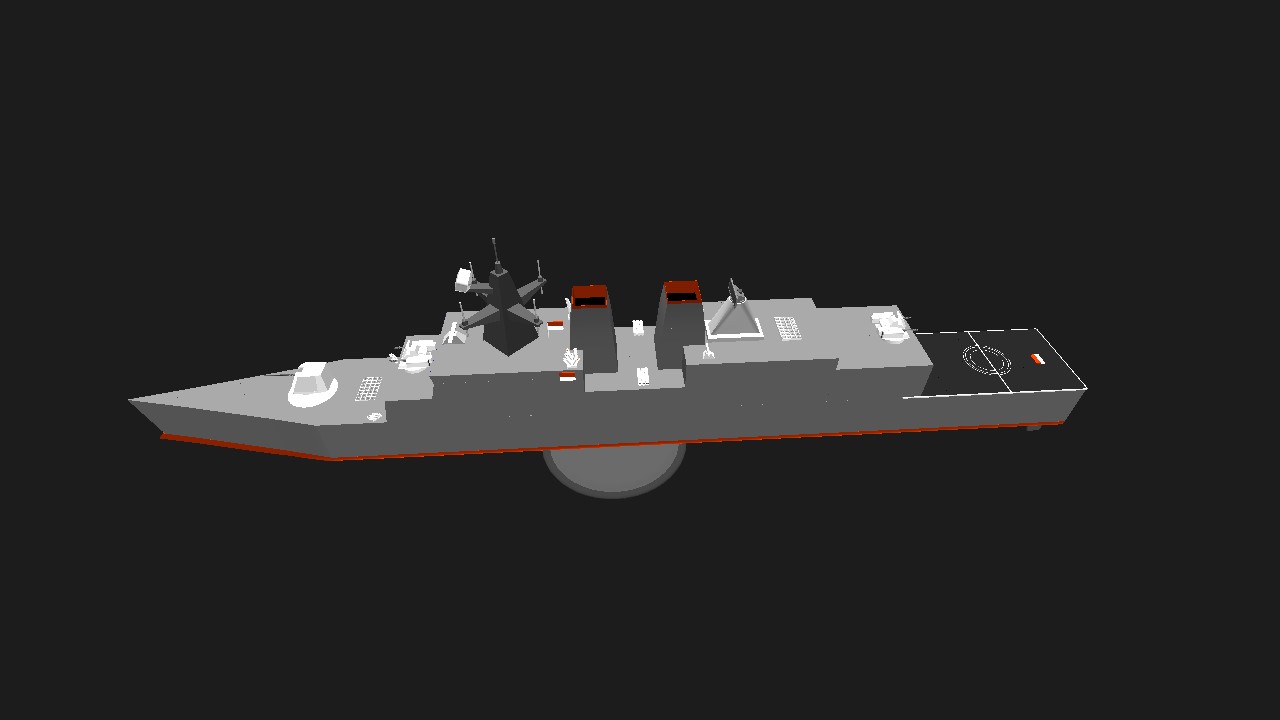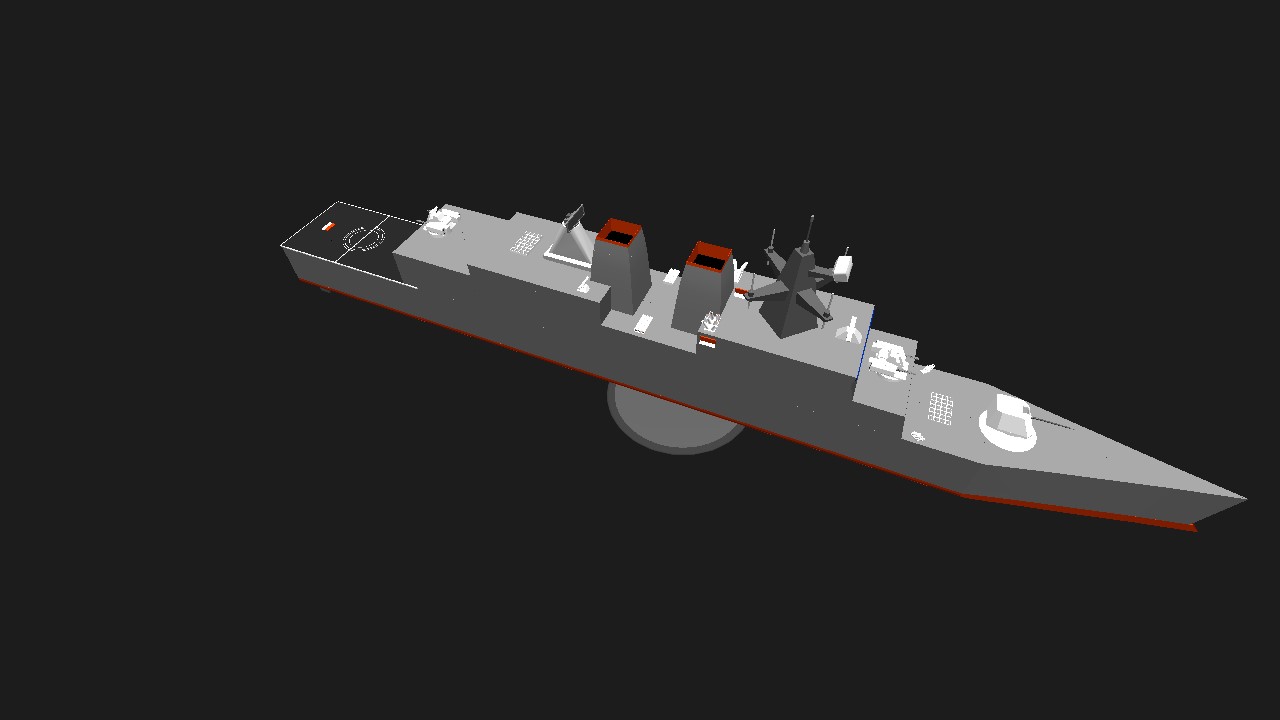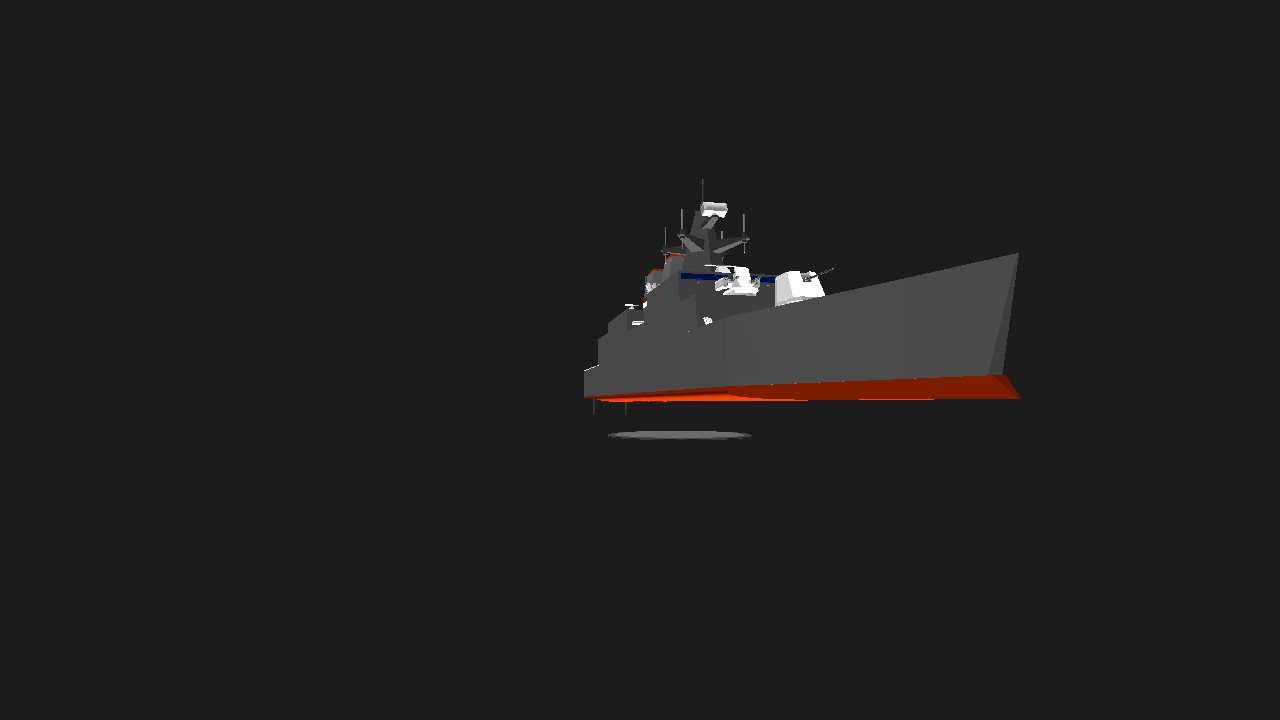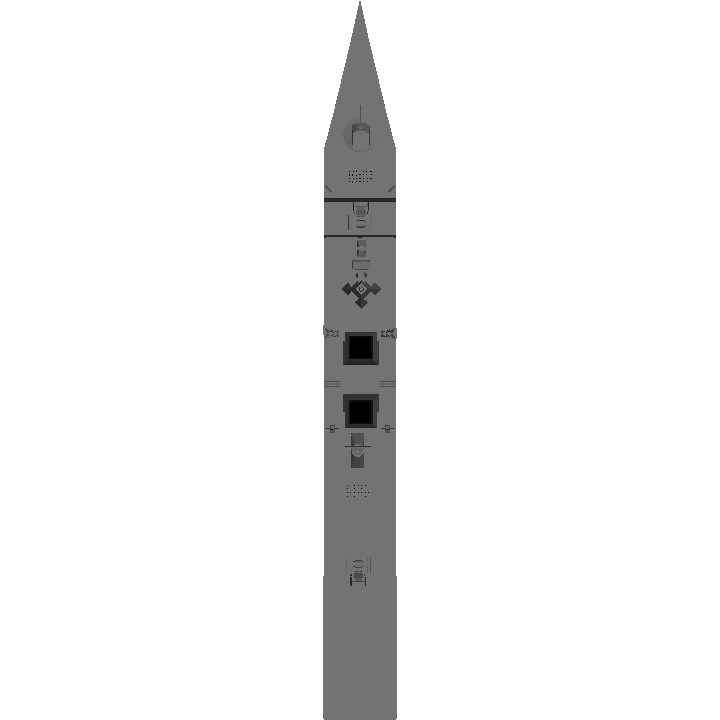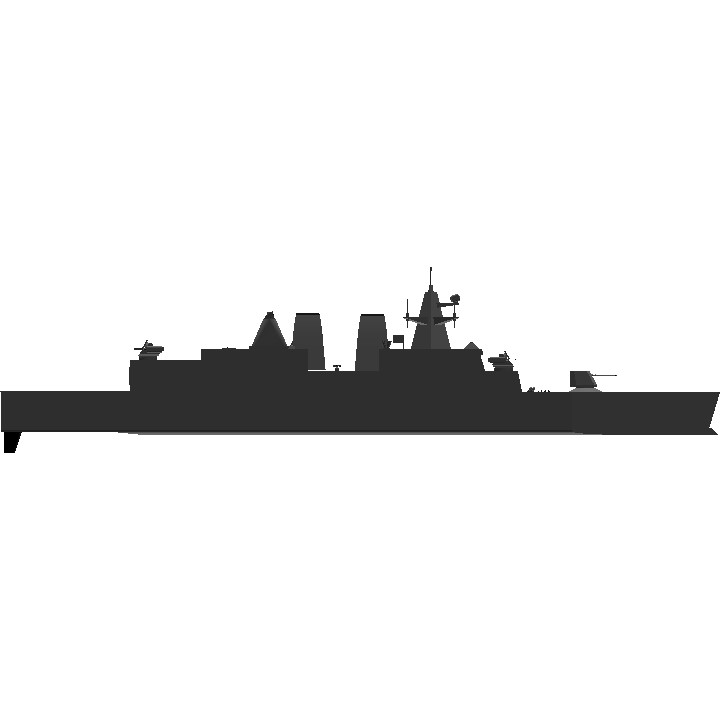here it is finally able to make a Destroyer Ship locally I made Alex Kawilarang CLASS as a Medium Class Destroyer Ship which is important I hope it doesn't need many Components it's quite simple it can compete with Chinese, Japanese, South Korean, United States, European, and British Destroyers. that way it can save time. Good luck and enjoy your voyage.
Alex Kawilarang
, his surname is Kawilarang.
Brigadier General TNI (ret.) Alexander Evert Kawilarang (February 23, 1920 – June 6, 2000) was an officer of the Indonesian National Army (TNI) during the Indonesian National Revolution and a former member of the KNIL. He was also the founder of Kesko TT which later became Kopassus. In 1958 he resigned from his position as military attaché in the United States to join the Permesta rebellion where he had to fight the Kopassus troops he had previously formed. His involvement in Permesta ended his military career with the TNI, but he remained popular and active in the armed forces community until his old age.
early life
Kawilarang was born in Meester Cornelis (now Jatinegara) on 23 February 1920.[1] He was born into a military family. His father, Alexander Herman Hermanus Kawilarang, was a KNIL major.[2] His mother was Nelly Betsy Mogot.[3] Both of his parents were from Remboken in North Sulawesi. Kawilarang was a Minahasan from the Toulour sub-tribe. He was also a cousin of Daan Mogot, the director of the Tangerang Military Academy who was killed in the Battle of Lengkong in an attempt to disarm a Japanese army depot in 1946.[4]
Kawilarang followed a comprehensive European education system. He received his basic education at a Europeesche Lagere School (ELS), first in Tjandi, Semarang and then in Tjimahi, West Java.[3] After finishing there, he continued to the Hoogere Burgerschool te Bandoeng (HBS Bandung, now occupied by SMA Negeri 3 Bandung and SMA Negeri 5 Bandung), equivalent to a junior high school/senior high school which lasts 5 years.[5]
After completing his secondary education, Kawilarang followed in his father's footsteps and entered military education, first at the KNIL Reserve Officers' Education Corps (Corps Opleiding Reserve Officeren, CORO) in 1940, which he continued at the emergency Royal Military Academy (Koninklijk Militaire Academie) in Bandung and Garut, West Java from 1940 to 1942. His classmates included AH Nasution and TB Simatupang.[6] After graduating, Kawilarang was placed in Magelang as a platoon commander and was later reassigned to Bandung as an instructor.[7] Later he also attended the Army Staff and Command School (SSKAD) in Jakarta.[citation needed]
During the Japanese occupation, the people of Manado, Ambon, and Indo were often arrested randomly because of their closeness to the Netherlands. Many were tortured cruelly by the Japanese Military Police (Kempeitai). Kawilarang was tortured several times by Japanese troops in 1943 and 1944. He survived, but suffered a lifelong disability in his right arm and had many scars.[8] In 1944, Kawilarang's father was thought to have died when he was a prisoner on the Japanese cargo ship Junyo Maru (see his father's prison card on the Dutch national archive site). The ship was carrying 3,000 prisoners of Manado, Ambon, Indo-European, the Netherlands, England, Australia, and the United States, and also more than 3,500 romusha when the ship was sunk by a ship English dive is called HMS Tradewind.[1] For the rest of the war, Kawilarang works in Sumatra, the last one is as the head of the rubber factory in Tanjung Karang (now Bandar Lampung) in South Sumatra.[1][9]
Indonesian National Revolution
After the proclamation of Indonesian independence on December 11, 1945 Kawilarang became a liaison officer with the British troops in Jakarta with the rank of Major. I West Java in Purwakarta.[10] In January 1946, he became Chief of Staff of the Bogor Infantry Regiment Division II West Java with the rank of Lieutenant Colonel.[11] In August 1946, he became the Commander of Brigade II/Surya Kencana which includes Sukabumi, Bogor, and Cianjur. This brigade is included in the newly formed Siliwangi division.[12][13] He led this brigade during the Dutch military aggression I. He also briefly led the I/Tirtayasa Brigade when the brigade was transferred to Yogyakarta.[1]
In mid-1948, Kawilarang was included in the contingent of government and military officials to Bukittinggi in West Sumatra. This step was to anticipate the second Dutch military aggression and to prepare for the formation of an Indonesian emergency government outside Java. On November 28, 1948, Kawilarang served as Commander of Sub-Territory VII/Tapanuli, southern East Sumatra. One of his duties was to stop the conflict between army groups in the area.[14] On January 1, 1949 during the Emergency Government of the Republic of Indonesia, Kawilarang was also appointed as Deputy Military Governor of the PDRI for the same region as Ferdinand Lumban Tobing was appointed as Governor.[15][16]
On 28 December 1949 he served as Military Governor of the Aceh and North Sumatra regions concurrently as Deputy Security Coordinator with the rank of colonel. On 21 February 1950, he was given additional trust as Commander of the Army and Territory (TT) I/Bukit Barisan based in Medan to anticipate Dutch recognition of Indonesian sovereignty after the Round Table Conference.[17] During his career, Kawilarang also served as territorial commander in two other important regional commands: Army and Territory VII/East Indonesia (now Kodam XIV/Hasanuddin) on 15 April 1950 and Army and Territory III/Siliwangi (now Kodam III/Siliwangi) on 10 November 1951.[18] On 17 October 1952, Kawilarang together with a number of other military figures (including AH Nasution and TB Simatupang) were involved in what is known as the 17 October Incident, which opposed government interference in military affairs.[citation needed]
Expeditionary troops to East Indonesia
At the age of just 30, Kawilarang was appointed as the commander of the expeditionary force on April 15, 1950.[19] He was assigned to crush the rebellion from former KNIL troops who included Andi Azis in Makassar, South Sulawesi. The expeditionary troops consisted of several brigades, including those led by Suharto and Joop Warouw.[20] On August 8, 1950, the fighting stopped after negotiations between Kawilarang and the Dutch general named Scheffelaar.[21]
At the same time, Kawilarang also organized forces against the Kahar Muzakkar rebellion and the separatist movement of the Republic of South Maluku (RMS). The fighting in Maluku was fiercer because the opponents were former KNIL soldiers from Maluku who were part of the Green Caps troops.[22] The resistance was finally crushed in November 1950. Colonel Slamet Riyadi was one of the troop commanders under Kawilarang who was killed on the last day of the military campaign.[23]
Slapping Suharto
When he served as Commander of TT VII/Eastern Indonesia, Kawilarang had just reported to President Soekarno that the situation in Makassar was safe. However, Soekarno instead offered a radiogram that he had just received which reported that the Dutch KNIL troops had occupied Makassar. It turned out that the Mataram Brigade, the troops who were supposed to defend the city of Makassar, had fled to the Mandai Airfield. Kawilarang was furious and immediately returned to Makassar. Arriving at the airfield he immediately scolded the Mataram Brigade Commander, Lt. Col. Suharto, while slapping him. In one interview, Kawilarang denied that he attacked Suharto, but he admitted that he had to reprimand him at that time.[24]
Special Forces
The experience of fighting in Maluku encouraged Kawilarang to form a force that became the forerunner of the Special Forces Command (Kopassus).[25] Several sources note that the idea for this special force was the brainchild of Kawilarang and Riyadi.[26][27] On April 15, 1952, Kawilarang established the Territorial Army Command Unit III (Kesko TT) in Batujajar, West Java, when he was Commander of TT III/Siliwangi.[28] He asked Moch. Idjon Djanbi, a former KNIL commando, to train the unit.[29] In 1999, a year before his death, Kawilarang became an honorary member of Kopassus and received a red beret at a ceremony commemorating Kopassus' 47th anniversary.[30]
Military Attaché in the United States
In August 1956, Major General Nasution as the Army Chief of Staff appointed Kawilarang as the Indonesian Military Attaché in the United States with the rank of brigadier general.[31] There are sources that say that the purpose of appointing Kawilarang as military attaché was to eliminate his influence as Commander of TT III/Siliwangi in West Java so that the position of commander could be held by an officer who would not threaten Nasution or even someone who was pro-Nasution.[31][32][33] Nasution took a similar step by replacing the Commander of TT VII/East Indonesia from Joop Warouw to Ventje Sumual.[34][35] Just one day before the handover ceremony, Kawilarang ordered the arrest of Foreign Minister Ruslan Abdulgani for his alleged corruption activities.[36] This step was supported by Zulkifli Lubis who was an opponent of Nasution.[37] Nasution eventually overturned Kawilarang's order and Abdulgani was released.[38] Regarding the appointment to Washington, Kawilarang himself stated that the position was offered by Nasution and he accepted it because Kawilarang wanted to gain more military knowledge abroad.[39]
The Great
Due to dissatisfaction with the central government due to (among other things) the lack of regional autonomy, on March 2, 1957, Ventje Sumual declared the Universal Struggle Charter and the Permesta movement.[40] The center of the movement was in Manado and Minahasa in North Sulawesi. This movement united with a separate movement in Sumatra called the Revolutionary Government of the Republic of Indonesia (PRRI). Kawilarang monitored the situation from Washington and then concluded that the central government in Java was the cause of the regional crisis.[41] In March 1958, he informed the Indonesian Ambassador to the US, Mukarto, that he would be leaving for North Sulawesi.[42] He left his post on March 22, 1958.[36] Upon his return to his homeland, he served as Commander-in-Chief/Supreme of the PRRI Revolutionary War Forces (1958) and Chief of Staff of the PRRI Revolutionary War Forces (APREV), with the rank of major general from February 1959 to February 1960. There are also other sources that say that Kawilarang had not fully accepted the PRRI side because he thought the PRRI was in line with religious extremists.[43][44] Kawilarang was the only officer who was not immediately dishonorably discharged by the central government for their participation in Permesta and PRRI.[45] Because of his doubts about PRRI, the central government still hoped that he would change his mind.[43][44] However, he continued to support Permesta and became Commander of the Permesta armed forces.[46][47]
In 1961, troops from the central government managed to suppress the resistance of the Permesta troops. These troops from Jakarta included officers who had previously been under the leadership of Kawilarang.[48] This conflict was resolved peacefully through the efforts of FJ Tumbelaka. Several ceremonies were held in April and May 1961 in which the Indonesian government officially received back the Permesta troops. Kawilarang participated in the ceremony on April 14, which was attended by Major General Hidayat and Brigadier General Achmad Yani from the TNI, both of whom were well acquainted with Kawilarang.[49] However, according to Kawilarang, an agreement had previously been reached that the Permesta troops would help the TNI to jointly confront the communists in Java. Therefore, Kawilarang felt regret when Nasution did not keep his promise.
"Des Alwi, a youth figure from 1945, called Kawilarang a genuine soldier who was honest and did not play politics. His action of slapping Soeharto was apparently never forgiven by the second president of the Republic of Indonesia, so that until Kawilarang died, he never spoke to his former superior. Only after Soeharto stepped down from his position and was replaced by B.J. Habibie, Kawilarang received an award for his services. [citation needed] Also because of his role in Permesta, he never received a military award like his fellow officers. On April 15, 1999, Kawilarang finally received recognition for his services in helping to form Kopassus. On the 47th anniversary of Kopassus, Kawilarang was accepted as an Honorary Citizen of Kopassus at the Kopassus Headquarters in Cijantung, East Jakarta. As a sign, he was awarded a red beret and a commando knife."
Civil life
In 1961, Kawilarang received amnesty and abolition from President Soekarno through Presidential Decree 322/1961.[50] His name was later rehabilitated. Kawilarang then retired from the TNI service, but his rank was reduced to retired colonel. He remained active in the military retiree community and Pepabri (Association of Retired TNI-POLRI and Warakawuri).[51] In the late 1960s, he submitted a proposal for the establishment of a flour factory and was granted permission by Soemitro Djojohadikoesoemo, as the Minister of Industry and Trade at that time. However, the permit was later transferred by Soeharto to Bogasari.[52] In 1972, Kawilarang served as deputy general manager of Jakarta Racing Management, which managed horse racing in Pulomas, East Jakarta.[53] The annual national horse racing competition is called the AE Kawilarang Memorial Cup.[54]
Died
On June 6, 2000, Kawilarang died at Cipto Mangunkusomo Hospital in Jakarta. He was laid in state in the Soedirman Room at the Kodam III/Siliwangi Headquarters in Bandung, followed by a military ceremony led by the Commander of the Kodam III/Siliwangi, Major General Slamet Supriyadi. Kawilarang was buried at the Cikutra Heroes Cemetery in Bandung.[55]
Family
Kawilarang was married twice. First to Petronella Isabella van Emden on October 16, 1952.[56] They divorced in 1958. Second to Henny Olga Pondaag, the ex-wife of Ventje Sumual, his friend in the Permesta struggle. From his first marriage, he had two children: Aisabella Nelly Kawilarang and Alexander Edwin Kawilarang. From his second marriage, he had a child, Pearl Hazel Kawilarang.
Specifications
General Characteristics
- Created On Android
- Wingspan 33.6ft (10.3m)
- Length 331.0ft (100.9m)
- Height 85.2ft (26.0m)
- Empty Weight 540,656lbs (245,238kg)
- Loaded Weight 4,734,385lbs (2,147,483kg)
Performance
- Power/Weight Ratio 0.001
- Wing Loading 60,025.3lbs/ft2 (293,069.4kg/m2)
- Wing Area 129.2ft2 (12.0m2)
- Drag Points 147588
Parts
- Number of Parts 529
- Control Surfaces 2
- Performance Cost 2,019

